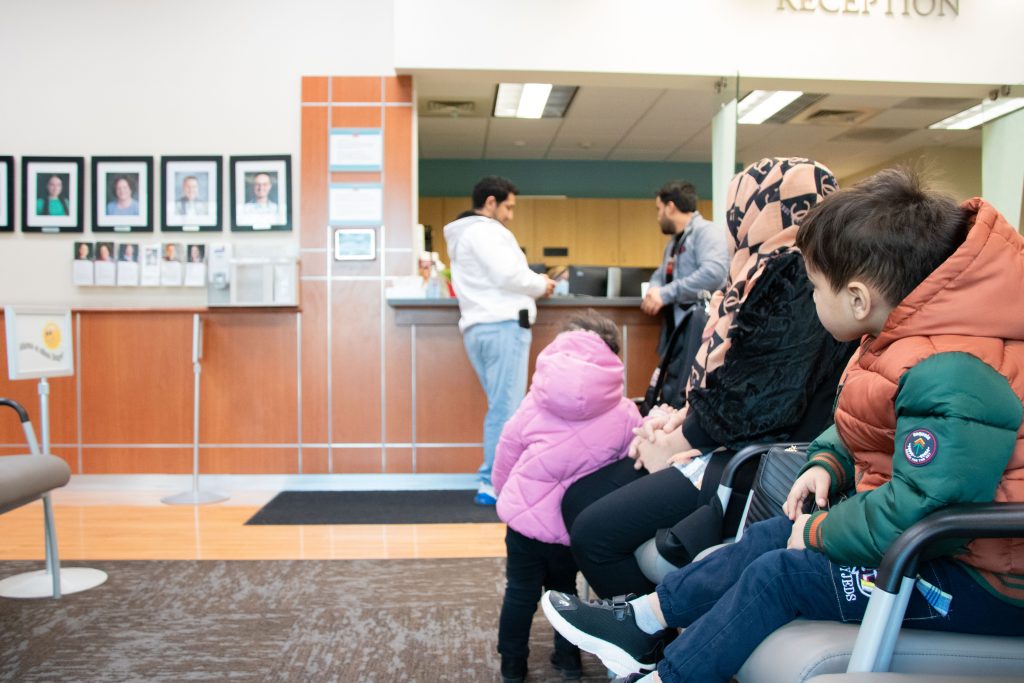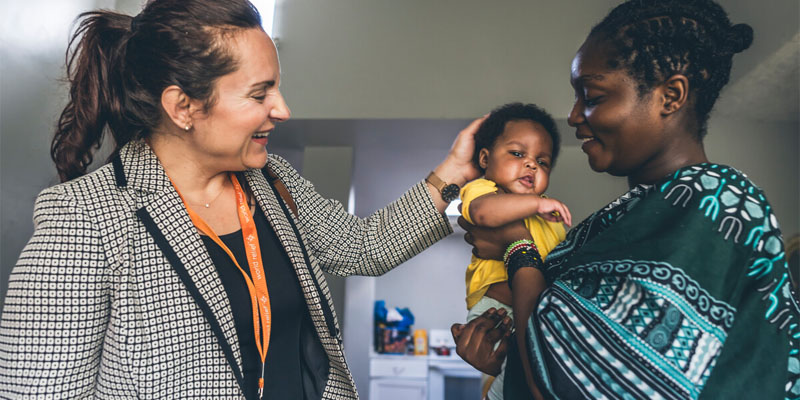Over the last 80 years, the work we’ve done together at World Relief has been defined by supporting those who have been displaced by conflict and global crises. Today, we’re looking back on our legacy of working with refugees and displaced people across the globe.
The world is currently facing an unprecedented displacement crisis with more than 110 million people forced to leave their homes — 36 million of these individuals have sought safety outside their home countries as refugees. Those are hard numbers to take in. And yet, as we look toward the future, we are inspired by our past.
Time and time again, we’ve witnessed the transformative impact the church and people like you can have when we move together, speaking out against injustices and mobilizing our people to respond to crises and suffering.
Here are just eight of the ways we’ve been working with refugees and displaced people throughout our history, and how you can join us in continuing this work today.
1. 1944 — FOUNDED IN RESPONSE TO THE DISPLACEMENT CRISIS IN EUROPE
In 1944, as World War II entered its sixth and final year, World Relief was founded in response to the displacement crisis in war-torn Europe.
By the time the war was over, an estimated 65 million people would be displaced across the continent. In response, members of Park Street Church in Boston fasted and prayed throughout the Lenten season. They collected their extra change in glass jars, which they brought together as a special Easter offering to help displaced people in Europe. Over time, their effort was replicated by other U.S. churches and eventually grew into the World Relief you know today.
2. 1950s AND 60s — WORKING WITH REFUGEES IN KOREA
Churches in the U.S. partnered with World Relief to support men, women and children experiencing displacement after the Korean War. Together, we established 140 feeding centers and provided 31,000 hot meals a day to hungry people. We also set up tuberculosis clinics, supported orphanages, planted churches and sent surplus food to those in need.
A decade later, in 1968, we launched a food-for-work project that employed 87,000 refugees and struggling farmers. Workers planted 22.5 million mulberry seedlings on 35,000 acres of land and cultivated silkworms and spun cloth, providing more than $100 million in assistance to hundreds of thousands of needy families.
3. 1970s — WELCOMING VIETNAMESE REFUGEES TO THE U.S.
After the Vietnam War ended in 1975, 1.6 million Vietnamese people were displaced. Evelyn and Grady Mangham along with their friends Tin and Kim Nguyễn worked with U.S. churches to welcome thousands of Vietnamese refugees to the U.S.
In 1979 Grady, who oversaw all of World Relief’s resettlement efforts, signed a contract with the U.S. State Department making World Relief the first and only evangelical organization authorized to resettle refugees at the time. Since then, with the help of volunteers and local churches, World Relief has welcomed more than 400,000 refugees and other immigrants to the U.S.
4. 1980s — SUPPORTING REFUGEES IN PAKISTAN AND SOUTHEAST ASIA
Following the Soviet invasion of Afghanistan in 1979, many Afghans fled to neighboring Pakistan seeking safety. World Relief provided food, blankets and cooking fuel and also set up health and sanitation services for refugees. What’s more, we conducted training so refugees could learn to weave and sell rugs to earn an income while living outside their country. Through our partners, we also provided medical services to those who were sick or wounded during battle.
In Southeast Asia, we worked with refugees in the Philippines, Bataan, Indonesia and Vietnam providing language classes, vocational training and medical support while helping refugees adjust to life in the camps.
5. 1999 — SERVING REFUGEES AND DISPLACED PEOPLE IN CHAD AND SUDAN
World Relief partnered with organizations in the Darfur Relief Collaboration to increase food security, provide urgent medical care, improve access to clean water and build latrines for 35,000 internally displaced people in Darfur.
We also worked to improve conditions for thousands of Sudanese refugees living in crowded camps in Chad and began resettling Sudanese refugees to the United States. Now, 25 years later, we’re still welcoming refugees and serving internally displaced people in Sudan. We also opened a permanent office in Chad, which enabled us to serve Sudanese refugees when war broke out in 2023. Read more about what’s currently happening in Sudan and what we’re doing to help here.
6. 2001 — WELCOMING “LOST BOYS” OF SUDAN TO THE U.S.
In 1987, civil war in Sudan forced more than 20,000 children (most of them boys) to flee their homes to escape violence. They made their way to Ethiopia before civil war in Ethiopia forced them to leave. They eventually settled in the Kakamu Refugee Camp in Kenya. This group of children became known as the Lost Boys of Sudan.
In 2001, nearly 4,000 of these Lost Boys were resettled in the U.S. World Relief was there to welcome them. Alongside our church partners, we helped hundreds of them acclimate to life in the U.S. Their challenges were significant because they were so young and had experienced significant trauma. Through programs like Good Neighbor Teams, we helped them learn or improve their English, navigate health challenges due to the extreme conditions their bodies faced, enroll in school and apply for jobs. We also offered group counseling with trained clinicians to process grief and trauma.
7. MID-2000s — RESPONDING TO THE SYRIAN REFUGEE CRISIS
In 2011, peaceful protests were met with violence from the Syrian government, instigating a complex civil war whose effects can still be felt today. Nearly 4 million Syrian refugees fled to neighboring countries and an additional 7.6 million were internally displaced. World Relief initiated a robust global response, working with refugees who had fled to Jordan, Turkey and Iraq, and by welcoming Syrian refugees to the U.S.
In places like Jordan, we worked with local churches to provide psychosocial support for parents and caregivers, created child-friendly spaces for kids to play and process what they had experienced, literacy support, water, sanitation and hygiene and more. We even translated our Welcoming the Stranger curriculum into German to support German churches who were welcoming Syrian refugees into their communities.

8. 2020s — SUPPORTING AFGHANS AND UKRAINIAN REFUGEES FLEEING CONFLICT
In August 2021, the U.S. military withdrew from Afghanistan, and Kabul fell to the Taliban. Many Afghans, especially those who had assisted the U.S. government, were left at considerable risk. Since the withdrawal, an estimated 84,600 Afghans have been evacuated to the U.S. Over the next year, World Relief staff, volunteers, church partners and donors helped welcome 3,419 Afghans to communities across the U.S., providing household supplies, community and support.
Six months later, in February 2022, Russia invaded Ukraine, sparking a war that continues today. An estimated 3.7 million people were internally displaced in Ukraine and more than 6.3 million fled the country as refugees.
World Relief responded, mobilizing churches to welcome Ukrainian refugees to the U.S. and establishing a new office in Ukraine to support internally displaced people affected by war.
WE CONTINUE THIS WORK TODAY ALONGSIDE PEOPLE LIKE YOU
For eight decades, we’ve been responding to the world’s greatest crises, walking with refugees and displaced people around the world, and we’ve done it in partnership with local churches and people like you.
Today, we continue this work in places like Haiti, Ukraine, DR Congo, Chad, Sudan and South Sudan where we’re supporting refugees and internally displaced people affected by conflict. In the U.S., we welcome thousands of refugees and other immigrants to local communities every year, creating the support network they need to thrive in a new country.
When you give to World Relief, you help refugee families rebuild their lives in the U.S. and enable us to respond quickly to the latest displacement crises while addressing the root causes of mass displacement around the world.
Together, we can respond to global crises with holistic, transformative solutions that help families flourish and communities thrive.
Rachel Clair is a Content Writer at World Relief. With more than 10 years of experience creating content and leading creative teams for churches and non-profits, she is passionate about connecting people to their creative gifts and developing content that helps people see the world in new ways. She holds a BFA from Stephens College and is currently participating in a spiritual formation cohort through the Transforming Center in Wheaton, IL.

